How die nuclear submarines die. Utilization of nuclear submarines. How the heirs of the cold war die
Rightholder illustrations Getty
Disposal of decommissioned submarines equipped with atomic power plants is a complex and laborious process, the correspondent writes.
Nuclear submarines have long stirred up the minds of Hollywood screenwriters - just remember the action movie “Hunt for Red October” or the 1960s TV series “Voyage to the Bottom of the Sea”. These warships always seem to be terrible instruments of geopolitical influence, silently gliding in the gloomy ocean depths on their top secret matters.
But when the service life of such a submarine ends, it turns into a floating source of radioactive danger, since hard-to-recover spent nuclear fuel is on board. Naval forces with nuclear-powered submarines have to make enormous efforts to dispose of the aging legacy of the Cold War.
As a result of this work, nuclear submarine cemeteries have arisen. They can be found in the north of the US Pacific coast, beyond the Arctic Circle, as well as near the base of the Russian Pacific Fleet in Vladivostok.
Submarine cemeteries differ from each other. The dirtiest and most unsafe of them, located on the coast of the Kara Sea in northern Siberia, are actually dumps of nuclear waste - reactors dismantled from submarines, and elements of spent fuel dot the seabed at a depth of three hundred meters. Apparently, until the early 1990s, Soviet sailors disposed of nuclear and diesel-electric submarines in this place, simply flooding them in the sea.
Rusty remains
The cemetery of diesel-electric submarines in the Deer-lip fjords in the north-west of the Kola Peninsula, in the Arctic part of Russia, looks surreal: here are both the rusted nasal parts of submarines with exposed channels of torpedo tubes, and dilapidated logging hayed at unnatural corners, and destroyed hulls similar to the shells of mollusks, broken by seagulls on stones.
Rightholder illustrations Getty Image caption Submarines "Kostroma" and "Pskov" laid upAccording to Bellona, an international environmental organization headquartered in Oslo, Norway, the Soviet fleet turned the Kara Sea into an "aquarium full of radioactive debris." About 17,000 containers with radioactive waste, 16 nuclear reactors and five nuclear submarines, completely flooded, are resting on the seabed - at one of them both reactors are still filled with fuel.
Now the oil and gas companies are looking at the Kara Sea region. If, during the drilling of a well, the protective shell of the reactor or fuel cells is accidentally damaged, it may cause radioactive contamination of fisheries, Bellona managing director Niels Bomer warns.
Official submarine cemeteries are another matter. They can even be found on Google Maps. If you look at high-resolution satellite photographs of the largest US nuclear waste repository in Hanford, Washington, storage facilities at Saida Bay on the Kola Peninsula or shipyards around Vladivostok, you can see rows of steel tubing containers, each about 12 meters long. At Hanford, the containers are buried in long earthen trenches, awaiting burial. At the docks of Sayda Bay, they are stored in even rows, and in the Sea of Japan they are moored to the pier on the basis of Pavlovsk submarines near Vladivostok.
Fuel removal and reactor removal
These containers, known as three-compartment blocks, are all that remains of hundreds of atomic submarines. They are fuel-free and hermetically sealed blocks of reactors that are created in the process of decommissioning submarines. The process has been perfected at the Navy Yard and intermediate service station at Puget Sound in Bremerton, WA.
Rightholder illustrations Getty Image caption So ends the life of a submarineThis is a painstaking process. First, the decommissioned submarine is towed to a special dock, where all liquids are drained from the reactor compartment, exposing spent fuel assemblies. Then, each of the assemblies is individually removed from the reactor, placed in containers for spent fuel and sent by rail for disposal to the plant for long-term storage and processing of used fuel. In the United States, this company is called Naval Reactors Facility, located on the territory of the Idaho National Laboratory, and in Russia it is the Mayak Production Association in the Chelyabinsk Region.
Although after these operations no more enriched uranium was left in the steam generators, pumps, valves and pipelines of the reactor compartment, the metal from which they were made, after decades of neutron bombardment, itself became radioactive. Therefore, after removing the fuel, the submarine is diverted to dry dock, where the reactor compartment, as well as the compartments directly adjacent to it, are cut out of the hull. Then thick steel caps are welded onto the cut fragment. Thus, three-compartment blocks are in fact hermetically sealed segments of the submarine itself. All non-radioactive components of the submarine are disposed of separately.
Rightholder illustrations Bellona foundation Image caption Reactors of nuclear submarines stored near VladivostokRussia is now also using this technology - the West once feared that, due to less stringent requirements imposed on the successor of the USSR to nuclear waste disposal processes, the spent fuel could be in the hands of terrorists. So, in Andreeva Bay, near Sayda Bay, the spent fuel from 90 submarines decommissioned between the 1960s and the 1970s is still stored. In 2002, the G8 member countries launched a 10-year program worth $ 20 billion to transfer US nuclear waste disposal technologies to the Russian Federation. Thanks to this program, Russian utilization standards have increased significantly, fuel storage conditions have improved, and a ground storage facility for decommissioned reactors was built.
Floating threat
According to Bomer, a safer ground storage was necessary because on Sayda the three-compartment units were simply left afloat (the air-filled compartments on either side of the reactor room provide buoyancy). And in Pavlovsk, 54 blocks are still kept afloat in the open air.
Rightholder illustrations Getty Image caption Soviet submarine K-19, photographed in 1972 off the coast of IrelandRecycling the reactor compartments in the manner described above is not always possible, Bome says. In some Soviet-built submarines, the reactors were cooled by an alloy of lead and bismuth, and not by water, as in common water-to-water atomic installations. After stopping the reactor, the cooler freezes, turning the reactor compartment into a monolith. Bomer says that two of these submarines are still not properly disposed of - they had to be towed to the remote parking of the Gremikha base on the Kola Peninsula away from harm.
Using the technique of three-compartment units, Russia has so far disposed of 120 nuclear submarines of the Northern Fleet and 75 - of the Pacific. In the US, this technology used for the disposal of 125 submarines from the Cold War. The method of three-compartment blocks resorts and France. But the nuclear submarines of the Royal Navy of Great Britain are designed in such a way that the reactor module can be removed from the hull without cutting it out together with the compartment. "The reactor is removed together with a protective sheath, placed in a container and transported to storage," - said the representative of the Ministry of Defense of Great Britain.
Rightholder illustrations Getty Image caption British nuclear submarine in the Strait of GibraltarHowever, it is still not clear when the UK plans to dispose of 12 decommissioned submarines laid up in Devenport in the south of England, as well as seven more submarines in the Scottish Rosaite, will be implemented: the government has not yet decided which of the five existing enterprises in the country should store them reactors and spent fuel. The delay in making a decision causes concern to residents of both cities, as the number of decommissioned nuclear submarines continues to grow there.
And the submarine fleet is growing ...
And environmental groups criticize the American method of storing spent nuclear fuel. Since 1953, when the first USS Nautilus nuclear submarine in the country was launched, the US Navy stored all spent fuel in the National Energy Department Laboratory in Idaho. “This laboratory tested an experimental reactor for the USS Nautilus; since then, all spent nuclear fuel from nuclear submarines has been sent to Idaho,” said Beatrice Brailsford, a representative of the environmental lobbying group Snake River Alliance. “It is stored above North America’s second largest aquifer of North America ".
Rightholder illustrations Getty Image caption The first nuclear submarine - the American "Nautilus"According to Brailsford, although the spent fuel is not buried, other types of waste from nuclear submarines are buried directly above the aquifer, and this practice can last more than half a century. “Many Idaho residents are concerned about this prospect,” she says. “Not only is fresh water at risk, but also the crops of the root crop, which our state is so famous for.”
Even with strict safety precautions, radioactive materials can be released into the environment - sometimes with the most unusual methods. For example, both the National Laboratory and the repository in Hanford at one time noted radiation leakage due to the rolling stock that fell into the cooling tanks of radioactive waste, collected the contaminated water, and then were blown off the wind outside the protected perimeter.
However, the fact that the safe disposal of nuclear submarines takes a long time and is expensive, does not affect the desire of military strategists to build new and new submarines. “At least, it seems that the US Navy considers equipping submarines with nuclear power plants as a very successful solution and is not going to switch to alternative energy sources,” said Edwin Lyman, a nuclear policy analyst at the Union of Concerned Scientists group based in Cambridge, Massachusetts.
Rightholder illustrations Science Photo Library Image caption Russia, like the US, does not intend to stop - plans to build new nuclear submarinesThe United States is not alone in the love of the nuclear submarine fleet: four such submarines are being built at Russian shipyards in Severodvinsk, and there are plans to build eight more such boats by 2020. "Despite the limited budget, Russia is determined to increase its nuclear submarine fleet," says bomer. China is doing the same.
So, by all appearances, there is no point in expecting a speedy desolation of the cemeteries of submarines and spent fuel storage facilities.
The word "submarine" conjures up something exciting and mysterious. Since humanity invented submarines, they have served as the support and scourge of the navy of every country, it is terrible to become its goal, and inside it turns out to be eerie too ... most of the inhabitants think so. But just as in the case of other useless military equipment (remember the cemeteries of tanks or airplanes), the final death of a submarine can be expected for quite a long time. In this article we will look at 10 abandoned bases where decommissioned submarines are awaiting disposal.
10. Kuril Islands, Soviet Union
In 1982, the New York Times reported that the USSR had allegedly built a remote secret submarine base somewhere in the northern part of Simushir Island. Only 400 kilometers from the coast of Japan, and this news was first published precisely in a Japanese newspaper, but no facts about it were stated.
But as it turned out later, there was something to tell about ...
Simushir Island is one in the chain of islands formed by volcanic processes, with a unique natural formation - an open caldera - in its center. When you look at this place, the supervillain’s lair or the secret submarine base immediately comes to mind ... so its creators thought so.
In the late 1970s, the Soviet military blew up the shipping channel to Broughton Bay. Over the next decade or so, a city was built around the base, which became home to about 3,000 people. Three docks, of which only one was preserved, were used to rest submarines between flights. One of the submarine missions was to lay explosives along the shores of Japan in case of war. Supposedly, a radar station with an extensive radius of coverage was also installed on the island.
There were rumors of a super secret base, and now they are rusty debris. Bizarre, strange rusty ruins. The name and date of foundation of this place are written on huge signs, maps and frescoes still adorn the walls, and the rusty skeleton of the long-damaged submarine still floats in the caldera.
9. Decommissioned Submarines in Devenport, England

Not all underwater cemeteries are far from civilization, on uninhabited islands, like a den of supervillains. In 2002, Britain needed a place where it would be possible to store nuclear submarines withdrawn into a reserve, most of which were created during the Cold War and are now outdated. They were towed to the base Devenport - two steps from nearly a quarter of a million people in England, and these people were not at all pleased with this neighborhood.
In October 2014, another submarine that had once been in the service of Her Majesty, the Indefatigable, joined other “brethren” who rust at the docks, while their nuclear engines remain intact. And although most military officials claim that the place where they are kept is absolutely safe, there is still the question of storing radioactive waste that will inevitably appear when dismantling submarines, if there ever is one, although this is not the case. The military do not even name the place where they will dump the waste, leaving the residents of Devenport in anxiety.
Now on the improvised cemetery there are 12 submarines. The oldest “Conqueror” arrived here in 1990. Over the next eight years, it is planned to add another 8 submarines to the already existing ones, and this is not at all what the locals would like. These 12 submarines mean approximately 25 tons of radioactive waste. And although they were talking about a different place of their storage, residents of Devenport, apparently, will have to wait a long time.
The submarine cemetery is a strange sight. Once they were on the front line of defense, they were deadly, dangerous, they defended the nation. It was a different era, and now people just want them out.
8. Lonely destroyed submarine off Coney Island
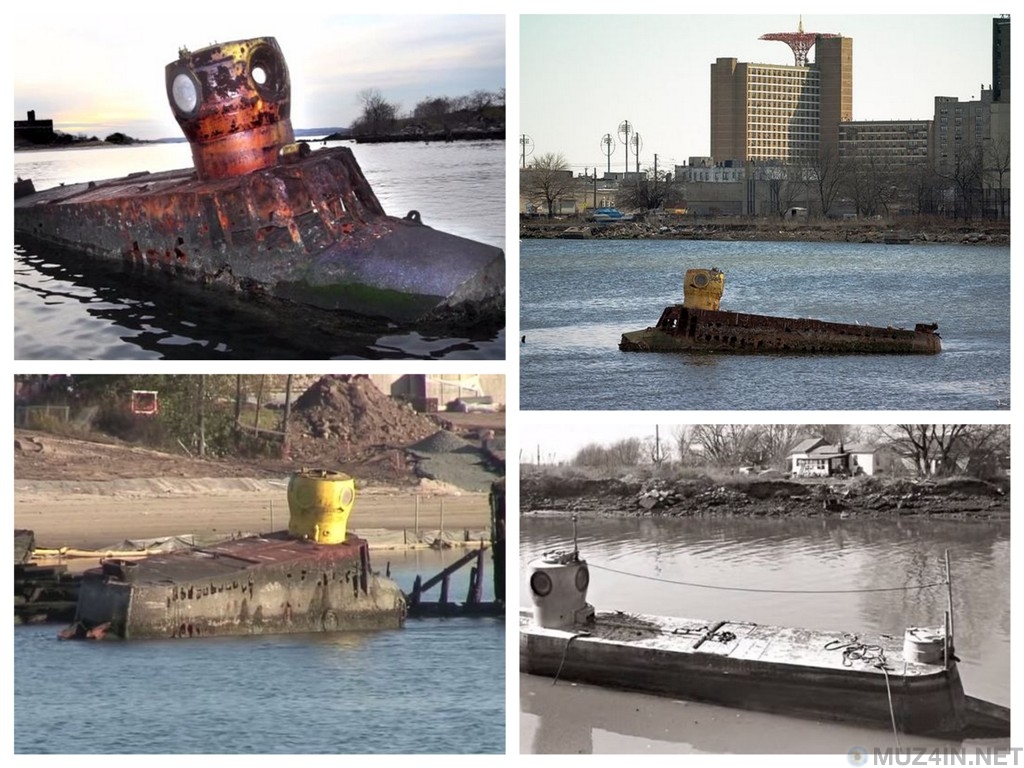
Technically Coney Island Creek (New York) is a submarine cemetery. There is only one ship, but the story of how she got there is just incredible.
Around the rusty hulk towering above the water, there are a lot of stories and legends inspired by Jules Verne ...
In 1956, the ocean liner "Andrea Doria" sank off the coast of New York. At that time, it was one of the largest cruise liners that made flights between Europe and America for three years. During the crash, he took with him the lives of 46 people, as well as many values. According to the law of the sea, everything that is on board the wreck belongs to the one who can get it. There was a fortune on board the Andrea Doria, and Jerry Bianco, the designer of the boat abandoned off the coast of New York, wanted to get it.
Working for the Brooklyn Navy Yard, Bianco decided that the treasures of the “Andrea Doria” are worth the investment, and it makes sense to build a submarine that can descend 70 meters and lift everything possible from the bottom. After four years of hard work, Bianco and his two sons built the 12-meter “Quester 1” submarine. She was painted bright yellow due to the fact that it was the cheapest paint.
A bottle of champagne is broken about the board, and the submarine is launched into the water. But the crane operator did not adhere to the instructions of Bianco on the descent and removed from the plan a couple of seemingly irrelevant points. Among such points was the requirement to lower the vessel into the water not completely, but only on one side. The operator of the cargo crane did exactly the opposite, as a result, the boat partially sank.
Investors abandoned the project, and the submarine remained in the water. It is still there, and it is a favorite place of blue crabs and seabirds.
7. Balaklava, Crimea, USSR, Ukraine, Russia

Once known as the “825 GTS facility”, the submarine base, located in the city of Balaclava, was a top secret facility. An underground canal made in the rock leads to a dry dock equipped for the repair and storage of weapons. Construction of the facility began in 1957.
Plans for abandoning the use of the base began to appear in 1991, and in 1996 the base was closed. Although the exact date when it ceased to function, no. By the time it was a very large object, able to withstand a direct nuclear strike. In addition, in an emergency there could be an air-raid shelter, where 3,000 people could find shelter.
Now guests of this small town can visit a former military facility and see all its cold and terrifying power. Basically it remained unchanged, with its long, cold corridors, concrete walls and doors that were designed to withstand a nuclear strike. Cold, thick, heavy and still impenetrable, even after decades of oblivion.
The base had one more purpose. A top-secret Russian program for training dolphins for military missions was conducted here, for example, laying explosives and beacons on enemy ships and submarines.
6. Hara, Estonia

The old Soviet submarine base in the village of Khara was abandoned not so long ago, but it looks as if nobody has been here for several generations.
Built between 1956 and 1958, the base was once a key target of Soviet military operations in Estonia and continued to be so for almost four millennia. If the base itself looks a bit unconventional, it is because it is built of stone taken from the walls of nearby villages. The remains of the old lighthouse still rise above the water, recalling that once there was a noisy military base.
The little that was left metal, rusted completely. All this looks very regrettable. Street artists use surfaces for their graffiti exercises. And now it seems impossible that people who saw this base in all its might are still alive.
The Baltic countries never took Soviet power. In 1989, 2 million people united in a peaceful protest, which attracted the attention of the whole world. Three years later, the base was abandoned, and now it is a dark reminder of dark times.
5. Submarines of the First World War on May Island

During the First World War, an incredibly shameful phenomenon in the history of mankind, an event occurred that was immediately classified, and it became known to society only after the end of hostilities, when not a single participant was left alive. The event was called the “Battle of the Isle of May,” although in reality there was no battle as such, and there were no enemy forces either. In fact, significant losses occurred during the exercises of the British Navy.
Submarines of class K participated in the exercises. They were incomplete, ineffective and extremely dangerous. There was a saying that those who went to serve on these submarines, entered the suicide club. A total of 18 boats of this type were built, they were never used in real combat conditions, 6 of them died in accidents.
The ships and submarines of the royal fleet were heading to Scapa Flow in Scotland when the tragedy occurred. It all started with the collision of two leading submarines. After that, other boats were involved in the accident, as well as the flagship. As a result, two submarines sank, the entire crew of the K4 died, as did the K17 crew, of which 59 only managed to save eight.
For a long time, no one talked about what happened. In the end, a small memorial plaque appeared in the neighboring village, but this happened only when historians began to study this cemetery of the ill-fated class K submarines.
4. Sazani Island, Albania
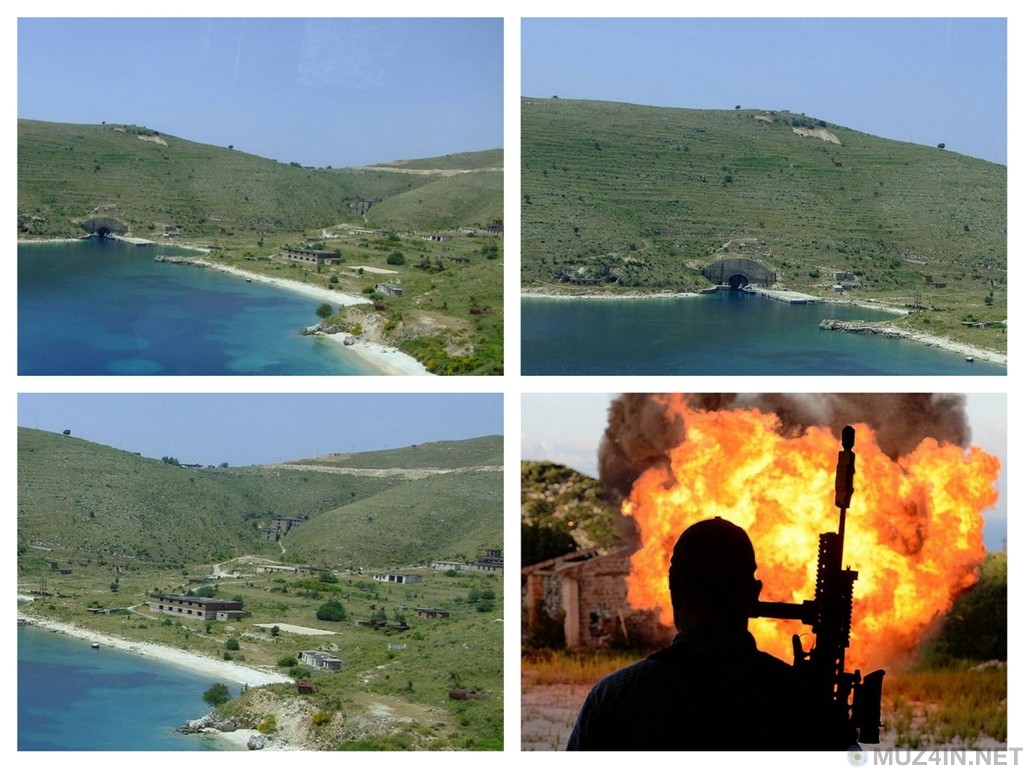
Sazani is a small island belonging to Albania. At one time there was a Soviet submarine base, equipped with a small number of submarines. In 1961, Albania refused to participate in the Warsaw Pact, and the Soviet base was captured along with all submarines.
By the 1990s, all submarines were outdated, but nonetheless the Albanian authorities did not decide to replace them. The base fell into disrepair and was almost abandoned. Now plans are being made to open the island as a tourist object, however, there has been no noticeable progress so far. At the moment, desolation reigns here, in sharp contrast to the beauty of nature.
In addition to all, the base is a labyrinth of underground tunnels where biological and chemical weapons were developed. Now it is a small outpost, which is mainly used to monitor smuggling activities between Albania and Italy.
More recently, the base has acquired something like a second life - as a training camp for the royal navy. In 2013, US marines conducted scenarios on this Cold War relic with scenarios involving pirates and terrorist organizations.
3. Old base at atoll johnston

Johnston is one of the most remote military bases in the world. The atoll in the middle of the Pacific Ocean was discovered quite by accident when an American captain ran aground on an island. In 1926, the atoll was a shelter for birds, and in 1930 its location is already extremely important for military service. Excavators were used to increase the usable area. Several more islands were added, and soon the base became one of the most important stations for refueling, maintenance and repair of aircraft and submarines.
In its heyday, 1,300 people lived and worked here, and in the 1940s the station became the most famous facility where nuclear weapons were tested. Now there are still a lot of problems associated with this place, including pollution after nuclear tests and other military operations. The atoll chemical weapons destruction facility was responsible for the release of Agent Orange into the environment. But tests of weapons that continued in the 1950s and 1960s led to constant emissions of petroleum products.
Currently, the object is under the control of the US air force, but as soon as the contract expires, this place will become a reserve.
2. Island Vis, Croatia

Today Vis attracts tourists from all over the world, and it is quite clear why this is a very beautiful place. He is quite secluded, but settled it back in 397 BC. er
The island became a strategically important, decisive place for the military base much later. The first of the modern military tunnels was dug in the vicinity of Vis in 1944, when it became an extremely important place in the struggle for independence from the so-called "soft" dictator Marshal Tito.
Abandoned only in 1989, the island was shrouded in secrecy throughout its work as a military base. Abandoned underwater dock - one of the most significant objects left after demilitarization, hiding deep inside the mountain. After the end of World War II, it was one of the largest and most important military bases of Yugoslavia, and it was at this time that its main part was built.
A huge network of underground tunnels was able to provide full military support during the Cold War. There is still a military presence on this beautiful, incredibly picturesque island, and its surroundings make it even more unreal.
Now, 3,600 locals coexist with empty barracks, abandoned tunnels and abandoned dry docks. And they made tourism a living.
1. Sub Marine Explorer

Only a few of the first (we mean the 1870s and earlier) submarines experienced the ravages of time, and among them - the recently discovered Sub Marine Explorer. The place of her burial is incredibly beautiful, but the story is tragic.
Built by the German inventor, Sub Marine Explorer was one of the first submarines, and not military. The ship, resting in the waters of the Pacific Ocean, off the coast of Panama, was built in 1865 and did not belong to a military unit, but to a private company that used it to search for pearls.
Sub Marine Explorer, equipped with hatches for collecting oysters from the seabed, had to make the work much easier and, accordingly, more profitable. Inside there was enough space for six men, the boat had to be lit with candles. Compressed air was pumped into the ship when it was supposed to float. However, the developers did not take into account the phenomenon of decompression, which eventually led to disaster.
Several test dives were carried out before the vessel began to fully operate. But soon the dives became deeper and longer. Inventor Julius Krol died first. The disease developed for quite a long time, so the doctors did not tie it to the boat sinking to the bottom. And the team went down again and again, collecting pearls worth thousands of dollars, and eventually all were struck by the same mysterious ailment.
Today, the discovery of an old lonely submarine has opened the history of underwater travel on the other side.
Material prepared Lydia Svezhentseva - site
P.S. My name is Alexander. This is my personal, independent project. I am very glad if you liked the article. If you searched for something and did not find it, then you have a chance to find it right now. Below is a link to what you have recently searched. I would be glad if you will be twice useful.
Copyright Site © - This news belongs to the site, and is the intellectual property of the blog, is protected by copyright law and can not be used anywhere without an active link to the source. Read more - "About Authorship"
Have you been looking for this? Perhaps this is something that you so long could not find?
Nuclear submarines excite the minds of many people for a long time. These warships invariably appear as formidable instruments of geopolitical influence, silently gliding in the gloomy ocean depths in their top secret matters.
But when the service life of such a submarine ends, it turns into a floating source of radioactive danger, since hard-to-recover spent nuclear fuel is on board. Naval forces with nuclear-powered submarines have to make enormous efforts to dispose of the aging legacy of the Cold War.
Five countries have nuclear submarines (hereinafter referred to as nuclear submarines). It is believed that the life of the submarine is about 25 years. In Soviet times, the naval forces received more than 200 submarines. After the collapse of the Soviet bloc, most of them were withdrawn from the Navy. The Russian military was faced with the task of disposing them.
To understand the level of this problem, you should list the stages of decommissioning submarines:
1) It is necessary to drain (remove water, dry) coolant and unload nuclear fuel from the reactor
2) To cut, in the conditions of a stationary dock, the reactor compartment (the storage period of the dismantled reactor unit is from 70 to 100 years)
3) Dismantle the submarine equipment
4) Seal the compartments and cover with anti-corrosion material
5) tow the dismantled parts and equipment to the place of long-term storage
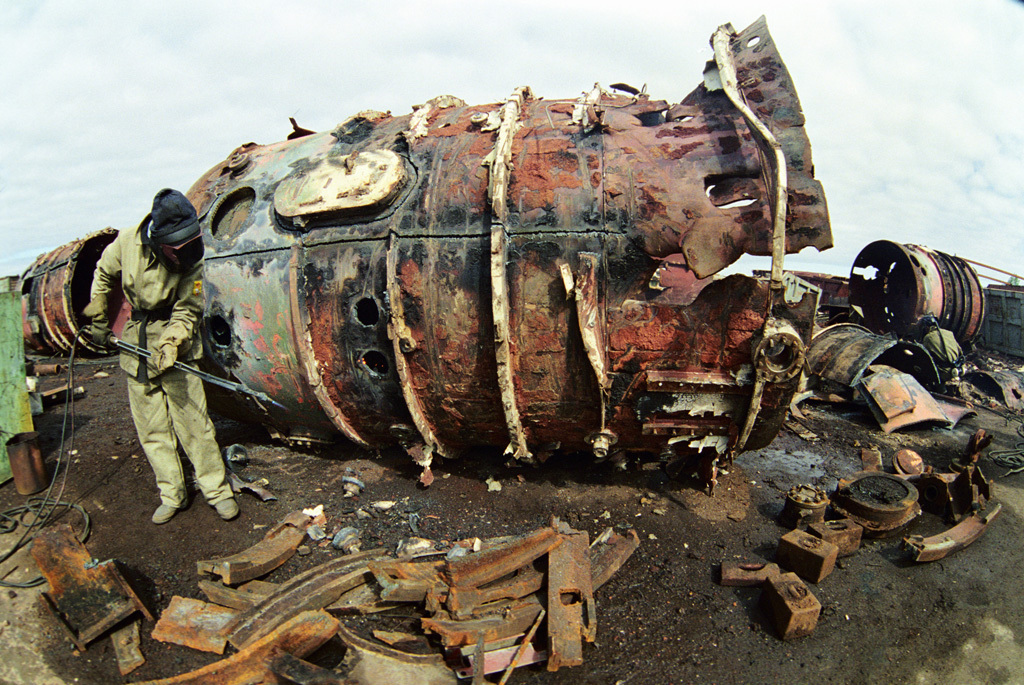
One of the stages of disposal.
This process is not only costly, but time consuming. So, in the United States unloading of nuclear fuel is about a year. In Russia, the existing nuclear fuel storage facilities are overcrowded and a large number of nuclear submarines have been waiting for their disposal for many years. Most of the submarines are disposed of in the Russian Federation at the Nerpa, Zvezda and Zvezdochka factories, Mayak. Submarines are delivered to the shipyards of these plants either by towing or on a floating dock.
As a result of the program for the dismantling of nuclear submarines, nuclear submarine repositories emerged. They can be found in the north of the US Pacific coast, beyond the Arctic Circle, as well as near the base of the Russian Pacific Fleet in Vladivostok. Submarine cemeteries differ from each other. The dirtiest and most unsafe of them, located on the coast of the Kara Sea in northern Siberia, are actually dumps of nuclear waste - reactors dismantled from submarines, and elements of spent fuel dot the seabed at a depth of three hundred meters. Apparently, until the early 1990s, Soviet sailors disposed of nuclear and diesel-electric submarines in this place, simply flooding them in the sea.

Dismantled submarine K-159, Kola Peninsula. Sank on the night of August 30, 2003.
According to Bellona, an international environmental organization headquartered in Oslo, Norway, the Soviet fleet turned the Kara Sea into an "aquarium full of radioactive debris." About 17,000 containers with radioactive waste, 16 nuclear reactors and five nuclear submarines, completely flooded, are resting on the seabed - at one of them both reactors are still filled with fuel.
Official submarine cemeteries are another matter. They can even be found on Google Maps. If you look at high-resolution satellite photographs of the largest US nuclear waste repository in Hanford, Washington, the repository at Saida Bay on the Kola Peninsula or shipyards around Vladivostok, you can see rows of steel tubing containers, each about 12 meters in length. At Hanford, the containers are buried in long earthen trenches, awaiting burial. At the docks of Sayda Bay, they are stored in even rows, and in the Sea of Japan they are moored to the pier on the basis of Pavlovsk submarines near Vladivostok.

Storehouse in Saida Bay on the Kola Peninsula. In the background - three-compartment blocks.
These containers, known as three-compartment blocks, are all that remains of hundreds of atomic submarines. They are fuel-free and hermetically sealed blocks of reactors that are created in the process of decommissioning submarines. This is a painstaking process. First, the decommissioned submarine is towed to a special dock, where all liquids are drained from the reactor compartment, exposing spent fuel assemblies. Then, each of the assemblies is individually removed from the reactor, placed in containers for spent fuel and sent by rail for disposal to the plant for long-term storage and processing of used fuel. In the United States, this company is called Naval Reactors Facility, located on the territory of the Idaho National Laboratory, and in Russia it is the Mayak Production Association in the Chelyabinsk Region.

NPS reactor.

Removing the reactor from the reactor compartment of the submarine project 705 "Alpha".

Have you ever wondered what happens to machines and other similar objects that have been decommissioned? Today, some of these objects are recycled, and many of them are accumulated in the so-called clothing cemeteries in anticipation of complete decomposition under the influence of time. Places of natural decay of such objects can be unusual tourist attractions, as well as ideal landscapes for amazing photos.
1. Aircraft cemetery, USA
309 The Aerospace Equipment Maintenance and Regeneration Group (AMARG), often referred to as “Boneyard,” is located close to the Davis Monthan air force base in Tucson, Arizona. For those who have never seen it in their life, it is very difficult to form an idea of its size. 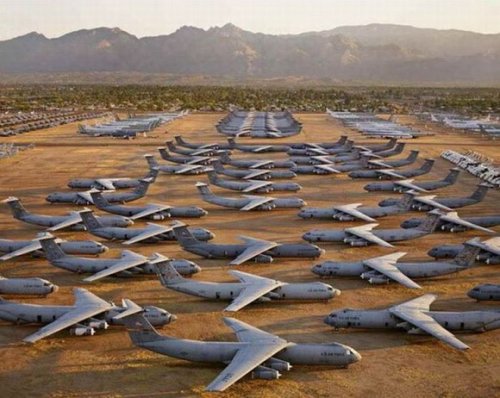
The number of aircraft stored there, as well as the accuracy with which they are parked, is really impressive. Another important fact is that they can all be returned to the service if the need arises. 
Entrance to this cemetery is strictly guarded and prohibited for anyone who does not have the appropriate permission. The only way to get to this cemetery, being an unauthorized person, is a bus tour, which is held by the nearby Pima Aerospace Museum. Bus tours are held from Monday to Friday. The Museum and Aircraft Cemetery are very popular attractions in the Arizona desert.
2. Ship graveyard, Mauritania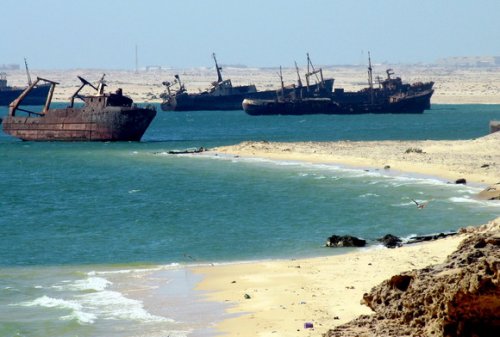
The city of Nouadhibou (Nouadhibou) is the second largest city in Mauritania and serves as the commercial center of the country. It is known for the fact that one of the largest ship cemeteries in the world is located on its territory. Here you can see hundreds of rusty ships in the water and on the beaches. 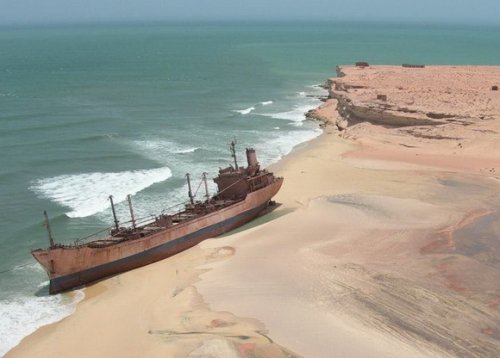
One of the most frequently cited explanations for this situation is that the officers of the Mauritanian port took bribes and allowed them to leave the ships out of service in the harbor and around the bay. This phenomenon began in the 80s after the nationalization of the fishing industry in Mauritania, many unprofitable vessels were simply abandoned there. 
The city of Nouadhibou is one of the poorest places in the world. People live right on these ghostly beaches, inside huge rusty trading barges.
3. Train Cemetery, Bolivia
One of the main tourist attractions in southwestern Bolivia is an antique train graveyard. It is located 3 km from Uyuni and is connected with it by old railway tracks. In the past, the city was the center of the distribution of trains carrying minerals on their way to the ports of the Pacific. 
The train lines were built by British engineers who arrived here at the end of the 19th century and formed large communities in Uyuni. Railway construction began in 1888 and ended in 1892. 
Basically, these companies used mining companies. In the 1940s, the local mining industry collapsed, in part due to a depletion of resources. Many trains were abandoned, thus forming a train graveyard. At the moment, negotiations are under way in Uyuni to transform the cemetery into a museum.
4. Aircraft cemetery at Vozdvizhenka airbase, Russia
Spattered with at least 18 gutted supersonic bomber Tu-22M bomber, remaining from the 444th heavy bomber aviation regiment, the Vozdvizhenka airbase resembles a post apocalyptic landscape. Entering this deserted place, located near Ussuriysk in Primorsky Krai in the Far East of Russia, 95 km north of Vladivostok and 65 km from the Chinese border, you feel as if you have stepped into the past. 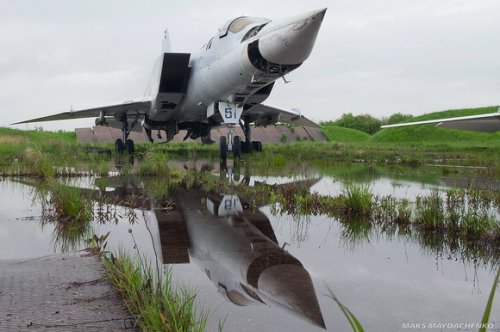
The 444th regiment was disbanded in 2009, some aircraft were transferred to the Belaya military air base, while others were dismantled (engines, equipment were removed, and holes in the fuselage were cut). 
Currently, aircraft frames are awaiting final processing for the metal, on the basis of the Khurba curfew airfield and on the territory of the 322nd Aviation Repair Plant.
5. Anchor Cemetery, Portugal
Among the dunes of the Portuguese island of Tavira (Tavira), you can find an impressive cemetery of anchors, called “Cemitério das Âncoras”. It was built in memory of the glorious tradition of tuna fishing with large nets fixed by these anchors (fishing technique invented by Phoenicians). 
Tavira was once a place dedicated to tuna fishing. Citizens created this cemetery of anchors, in memory of those fishermen who were forced to give up their favorite business, when a big fish left this coast.
6. Soviet Tank Cemetery, Afghanistan
On the outskirts of Kabul, in Afghanistan there is a massive cemetery of Soviet military equipment, which has remained here since the 1970s and 1980s. 
There are partially disassembled and graffiti tanks written by Soviet troops. 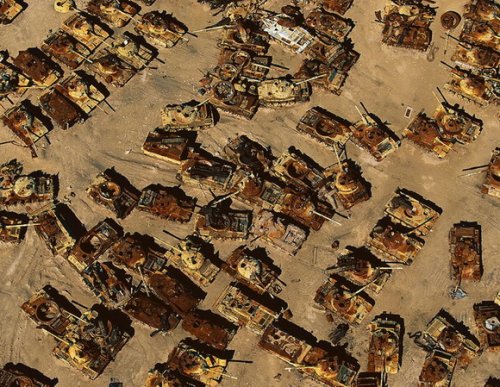
There are very few processing plants in Afghanistan, so this tank cemetery is likely to remain intact.
7. Submarine Cemetery, Russia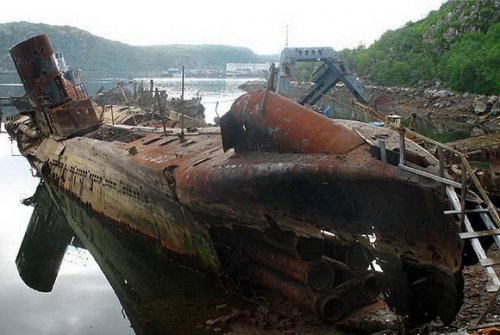
The area around the Bay "Invisible", located near the city Gadzhiyevo, in the Murmansk region on the Kola Peninsula, is a cemetery, where there are many old Russian submarines. After these submarines served their time, they were transported to this restricted area in the 1970s. 
According to locals, some of these submarines were used as a target in military exercises and often sank. Others were simply left in the bay.
8. Ship's cemetery in Muynak, Uzbekistan
Muinak is a city in northern Karakalpakstan, in western Uzbekistan. Due to the fact that since 1980, the population began to decline rapidly due to the drainage of the Aral Sea, at the moment there are only a few thousand people living here. 
The once lively city with a flourishing fishing industry, which was the only port city in Uzbekistan with tens of thousands of inhabitants, today Muynak is just a shadow of past glory, located tens of kilometers from the rapidly receding coastline of the Aral Sea. 
The main reason why travelers visit Muynak is a ship graveyard, a collection of rusty carcasses that were once part of the city’s fishing fleet. The ship graveyard in Muinak is an image that perfectly illustrates the catastrophe - the once proud ships are stranded in the sandy desert. 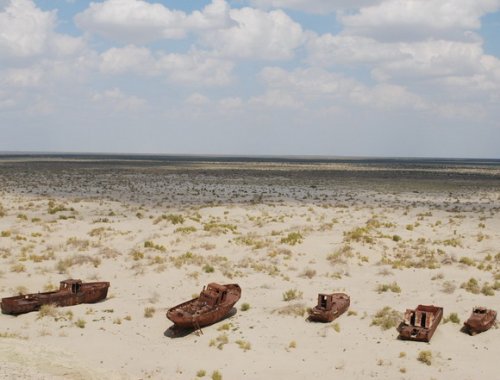
Unfortunately, there are not many ships left, as scrap metal recycling companies quickly dealt with them before the authorities responsible for tourism managed to ban it. The final blow to the already distressed local population was the fact that the money received from processing did not go to the people who owned the boats, but was divided between scrap metal recycling companies and government officials.
9. Taxi Graveyard, China
Thousands of failed taxis were abandoned at a site in the center of Chongqing, China. Traffic congestion and environmental pollution have increased dramatically in Chinese cities, due to economic growth in the country. Thanks to economic growth, the number of consumers able to afford cars has also grown, which means that many people will no longer have to rely on taxis or public transport.
10. Telephone Box Cemetery, UK 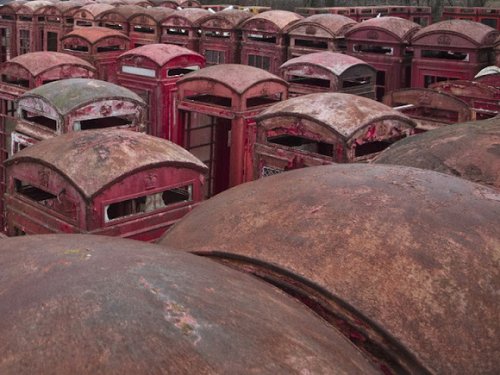
This telephone box graveyard is located between the cities of Ripon and Thirsk, near the village of Carlton Miniott, United Kingdom. There are hundreds of abandoned telephone booths. 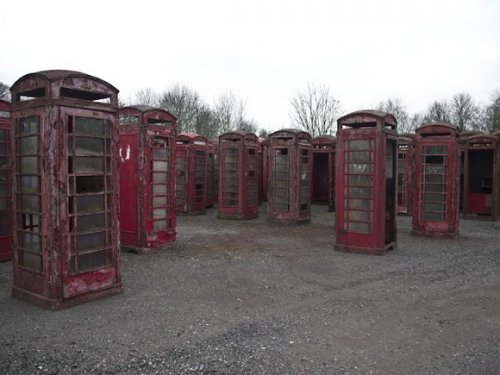
Decommissioned old red booths are systematically replaced by new modern cabins, and are sent to storage in this place, located near the English village.
August 11, 2014
Abandoned old cars, motorcycles, trains, ships and airplanes - a real treasure for fans of industrial tourism. We will talk about the largest clusters of abandoned equipment from around the world.
Train Cemetery in Bolivia
High in the Andes, in the south-west of Bolivia, is the world's largest salt desert - Salar de Uyuni. In 1888, when the local mining industry began to grow rapidly, British engineers were invited here to build a railway to the Pacific Ocean. Despite sabotage by the indigenous people of Aymara, who considered it a threat to life, the road was completed in 1892. However, by the 1940s, the mining economy collapsed due to the fact that mineral resources were exhausted. Since the railway was no longer used, many locomotives were simply abandoned in salt marshes. Even today, it looks unusual: a lot of rusty steam engines, many of which are made in the UK, are smoldering in the scorching desert sun. Since the fences and fences were removed, most of the metal parts were stolen - some disassembled parts were thrown around. There were some plans to turn this cemetery into a museum, but so far the trains have been abandoned at the mercy of local residents and the aggressive environment.
Car cemetery in Belgium
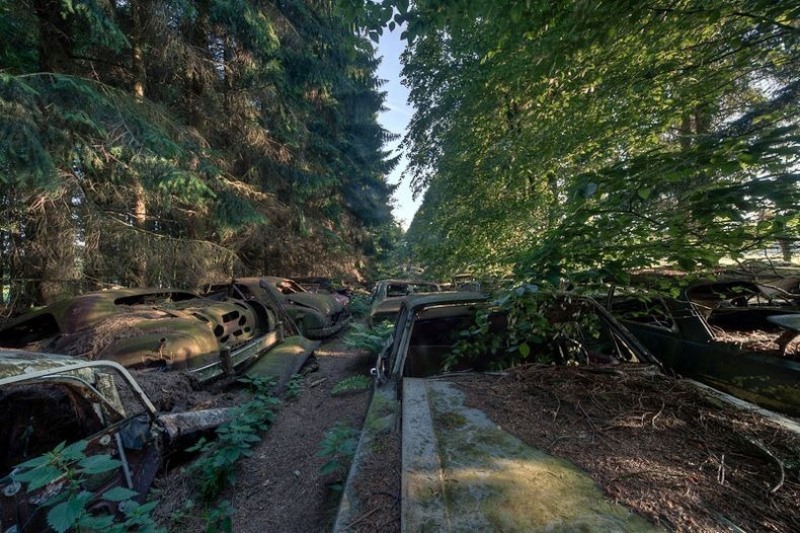
Until recently, dense forests around the small Belgian town of Chatillon were hidden from prying eyes by four cemeteries with more than 500 cars, slowly overgrown with moss and rust. There is still some debate about where they came from. Most people constantly tell stories that the cemetery appeared at the end of the Second World War, when American soldiers could not find a ship to ship them back home, so they simply left the forest. And then over the years other cars have been added to them. Another less interesting story is that it is just an abandoned dump. Most cars were produced in the 1950s and 1960s, and many of them are rare models. Judging by the fact that a large number of parts are missing, they were either saved by collectors, or they became the prey of souvenir hunters looking for trinkets. The last of the cemeteries was eliminated in 2010 due to environmental problems, but his photographs can still be found.
Landfill for diamond mining in Namibia

Oranjemund is a small town in Namibia, wholly owned by Namdeb, which is owned by the Namibian government along with the De Beers diamond cartel. The city is located near the mouth of the Orange River. It was specially built for workers near diamond deposits. Access to the zone is strictly organic - armed guards patrol the perimeter, and without special permission you will not be allowed through the turnstiles at the airport. Anyone who gets caught stealing diamonds faces 15 years in prison. There were cases when workers tried to hide diamonds in the nose or throw them over the fence using improvised crossbows. Once even a domestic pigeon was caught in a small vest filled with diamonds. In Oranjemund, there is also one of the world's largest fleets of vehicles for moving soil, which is second only to the fleet of the American Army. In order to prevent the illegal export of diamonds, a vehicle that has entered the mine is never returned from there. Some of these rusty cars, among which there are tanks from World War II (they were probably used to level sand), date back to the 1920s. Previously, the owners of the company proudly demonstrated this collection, but now they prohibit taking photographs of technology, believing that their image may suffer from this.
Ship graveyard in Mauritania

Nouadhibou, with a population of almost 100,000, is the second largest city in Mauritania - one of the poorest countries in the world. The city port, located in a wide bay, perfectly protects ships from the tides of the Atlantic Ocean, and also opens the way to the best fishing grounds in the world. Iron ore is exported through the port, making it an important trading center. In the 1980s, local residents began to leave in the shallow waters of the bay old, useless boats and larger ships. Soon in Nouadhibou began to leave unnecessary ships from around the world. The local authorities were only happy - they were given bribes for this opportunity. Now a huge number of ships are rusting in shallow water - from fishing trawlers to naval cruisers. One of the largest ships is the United Malik. He ran aground in 2003, carrying fish. Crew members (17 people) were rescued by the Moorish fleet, but since then the ship has not been removed. Despite measures to prevent further “dumping” of ships, their number continues to grow, although not as fast as before. The locals had little incentive to disassemble ships for scrap - this city is one of the largest exporters of iron ore. But everything is not so bad: wrecks are excellent places for spawning fish, and local fishermen often stretch their nets between them. Now the government is going to use the ships to form an artificial deep-water reef. True, these plans were announced in 2001, but since then nothing has been done to implement them.
Soviet submarines on the Kola Peninsula
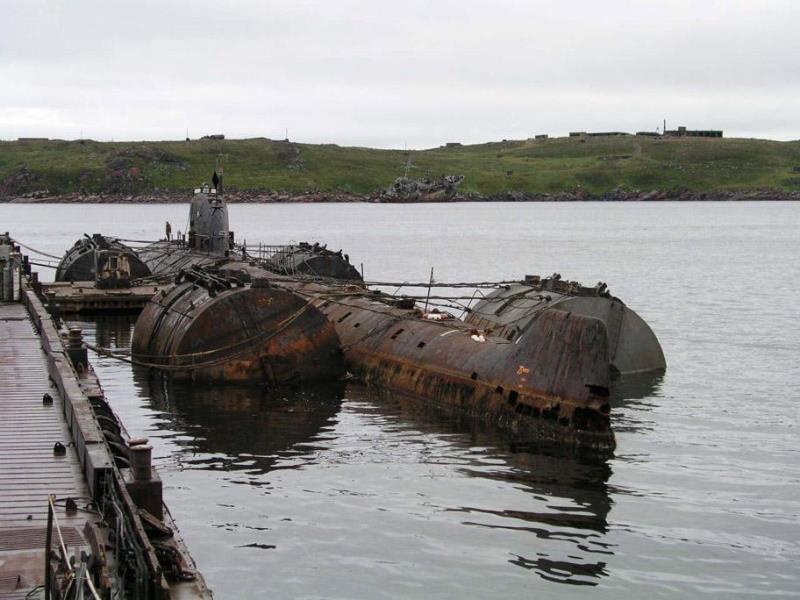
In the invisible Bay, located above the Arctic Circle in the far north of Russia, is a cemetery of Soviet submarines. Starting in the 1970s, military submarines, many of which are nuclear, were simply thrown into the bay on the isolated Kola Peninsula. Soviet shipyards were too busy ordering new submarines to dispose of old ones. Access is prohibited here without special permission, so there is not much information about the cemetery. It is only known that some of the submarines were dismantled in the 1990s, because of the danger of water pollution, but in the photos from Google Earth it is clear that at least seven submarines still remain in the bay.
Train dump in Barry, UK
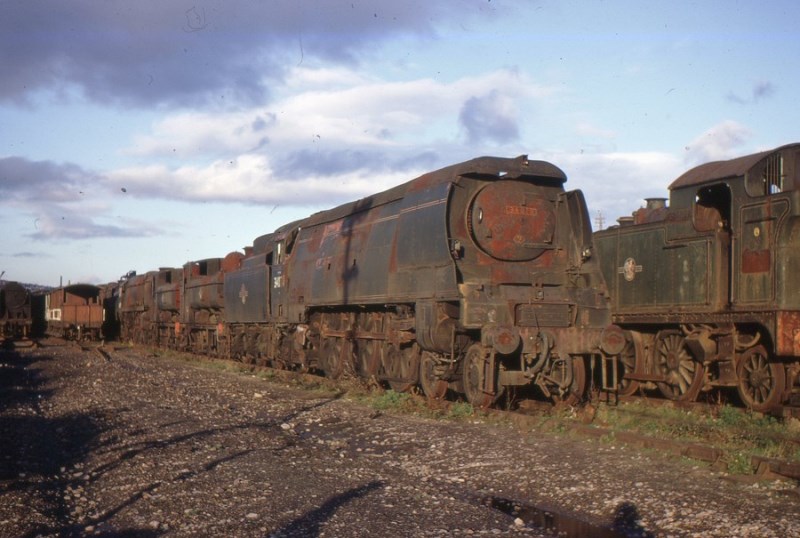
In 1955, the nationalized British railways announced plans to scrap most of their fleet. The recently decommissioned equipment included approximately 650,000 wagons and 16.000 locomotives. British railways were unable to cope with the volumes, and many of the trains were sold to private landfills for the processing of scrap metal. Among them was the Woodham Brothers dump in Barry, South Wales. At first, the locomotives were cut and started to be scraped immediately, but by the fall of 1965, the owner of the landfill, Dai Woodham, decided to focus on easier work - recycling of the wagons. Rusting steam locomotives remained on the street, where they soon became a popular city landmark. Enthusiasts soon realized that the Woodham Brothers provided an excellent opportunity to acquire rare locomotives for the surviving lines, which began to open across the country. Many of the models that were in the Daya dump were impossible to find anywhere else. In September 1968, the first rescued locomotive left the landfill, and the speed of salvage of locomotives only increased in the 70s. In the end, to the great surprise of Daya, 213 locomotives were removed. The latter left Barry in March 2013. Dai, who died in 1994, was very proud of his participation in saving locomotives for future generations. Today, many locomotives from his yard operate on preserved railway lines throughout the UK.
Motorcycle Cemetery in New York

In Lockport, New York, there used to be an old warehouse that became a real legend among motorcyclists. The warehouse once belonged to a man named Kol, who owned several motorcycle salons. Buying cheap Japanese motorcycles and broken ones, he soon amassed a huge amount of vehicles. In the 1970s, Kol bought a special room to store his huge collection, and in 1997 sold it along with the contents. The buyer, whose name was Frank, was going to use the warehouse to sell motorcycle parts. However, the building fell into disrepair, and Frank was unable to recoup the costs of its restoration. In the end, the warehouse was seized by local authorities, which is why no one else was allowed to look at the collection. By November 2010, most motorcycles were removed from the warehouse, with most of them going for scrap. Photos of the cemetery first appeared on Flickr in April 2010, as a result of which motorcycle enthusiasts began to search for this cemetery, and some even managed to buy rare motorcycles and spare parts. Photographer Chris Seward described this place in the most accurate way, saying: "This is certainly one of the most creepy and weird places I've ever been to."
Air Force Base in Lincolnshire, UK

The base of the Royal Air Force of the United Kingdom "Falkingham", located in Lincolnshire, was originally opened in 1940 as a spare fake airfield for another Air Force base. The Falkingham was equipped with aircraft models and service staff mock-ups before being transferred to US control in early 1944. Airplanes model Douglas C-47 "Dakota", located at the base, were used during the landing in Normandy during Operation "Neptune". The base was returned to the control of the air forces of Great Britain in April 1945 and closed in 1947, after which the British Formula One team from British Racing Motors conducted tests on its runways. It was reopened by the Royal Air Force in 1959 and was used as a storage place for the Thor thermonuclear missiles until its second closure — in 1963 its land was sold for agricultural use. Today, this old airfield is owned by Nelson M. Green & Sons Ltd, which uses it to store hundreds of vehicles that are being taken apart. Among the vehicles stored in this place are old Caterpillar bulldozers, tank trucks, cranes, tractors, as well as former military trucks and armored vehicles left over from World War II. There is even an amphibious vehicle DUKW, which was used during the landing of the Allied forces during the operation "Neptune". Also on the territory of the former base there are three sites where the above Thor missiles were located. At the moment, vehicles are still in place, waiting for their future.
Transport used to eliminate the consequences of the Chernobyl disaster, Ukraine

Because of the accident at the Chernobyl nuclear power plant not only people and buildings suffered from radiation. It affected a large number of vehicles that were used in extinguishing fires and cleaning the area. Since the tragedy, most cars are located in huge cemeteries, the largest of which is located in Rassokhi. But not all transport is located in the cemeteries - fire engines, which were the first to arrive in the disaster zone, had to be buried deep underground. On many dumps there are fire helicopters whose crews were hardest hit by radiation. It is frightening that some local residents were detained for trying to pick up metal parts of vehicles, despite the huge risk. Thus, the Ukrainian police arrested several people for attempting to remove one of the Mi-8 helicopters from the cemetery, which was used in a cleaning operation. These people intended to re-equip the helicopter and make it a cafe.
Aircraft Cemetery in Arizona, USA
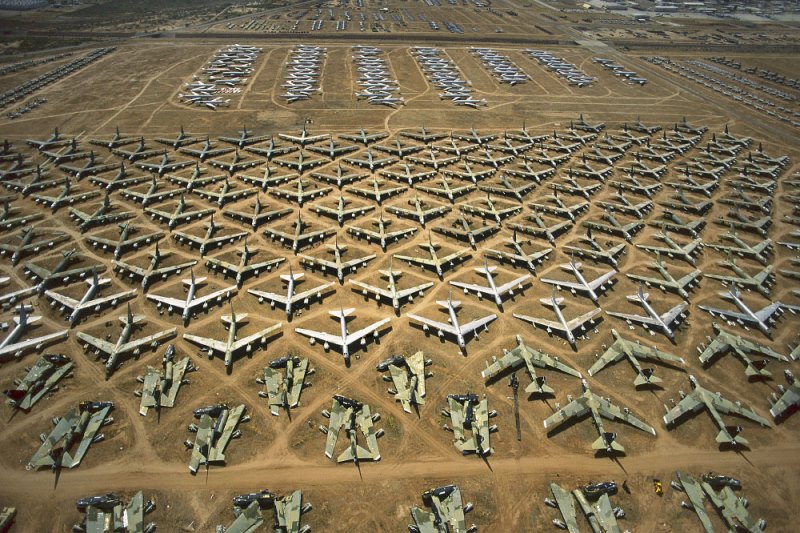
The 309th Aerospace Maintenance and Repair Group is located at the aviation cemetery, officially known as the Davis-Monten Air Force Base. It is a huge area for storing aircraft, which is located right in the middle of the Arizona desert. The size of this cemetery is equal to the size of 1,430 football fields. There are more than 4,200 aircraft here, with a total value of approximately $ 35 billion. It can be called the largest cemetery of military aircraft in the world. The aircraft stored here are divided into four categories: Category 1000 includes those that are well preserved and, if necessary, will be able to take off again; category 2000 aircraft are disassembled for parts; category 3000 - in good condition can be redistributed; The 4000 category includes obsolete aircraft, which are likely to become museum pieces or go for scrap. Among the fourth category there were many legendary B-52 bombers, which became scrap metal because of the 1991 treaty on strategic arms reduction with Russia.
